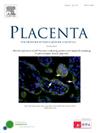在单绒毛膜成分的三胞胎妊娠中,较小的胎盘和母体血管灌注不良与较差的妊娠结局有关
IF 2.5
2区 医学
Q2 DEVELOPMENTAL BIOLOGY
引用次数: 0
摘要
本研究旨在比较基于绒毛膜性的三胞胎妊娠中胎盘病理表现以及母体、胎儿、产科和围产期结局的患病率。方法本研究为单中心、回顾性、观察性病例对照研究,纳入2000年至2024年在三级转诊医院进行胎盘病理检查的所有三胞胎妊娠。进行单变量统计分析。结果对111例三胞胎妊娠进行了分析,其中无单绒毛膜成分56例,有单绒毛膜成分55例。两组间产妇基线特征相似。有MC成分组的胎儿并发症明显更频繁,包括双胎输血综合征(p = 0.02;优势比[OR] = 0.44; 95%可信区间[CI] 0.35-0.55)、胎儿生长受限(FGR) (p = 0.03; OR = 2.05; CI 1.08-3.88)和宫内胎儿死亡(IFD) (p = 0.01; OR = 2.16; CI 1.16-4.01)。新生儿出生体重1500 g在MC组中也更为常见(p = 0.02; OR = 3.23; CI 1.51-6.92)。MC组胎盘最小(p < 0.01)。组织病理学上,含有MC成分的胎盘显示出更高的绒毛加速成熟率(p < 0.01; OR = 3.57; CI 1.88-6.77)和远端绒毛发育不全率(p = 0.01; OR = 2.00; CI 1.15-3.46)。我们的研究结果表明,具有MC成分的三胞胎妊娠与较差的妊娠结局相关,包括FGR、IFD、早产和低新生儿出生体重的发生率增加。患有MC的三胞胎妊娠也显示出较小的胎盘和更高频率的母体血管灌注不良病变。在三胞胎妊娠中观察到的MC成分的发病率增加可能反映了胎盘大体和组织病理学特征中可见的潜在生理改变。本文章由计算机程序翻译,如有差异,请以英文原文为准。
Smaller placentas and maternal vascular malperfusion are associated with worse pregnancy outcomes in triplet pregnancies with a monochorionic component
Introduction
This study aimed to compare placental pathological findings and the prevalence of maternal, fetal, obstetric, and perinatal outcomes in triplet pregnancies based on chorionicity.
Methods
This single-center, retrospective, observational case–control study included all triplet pregnancies followed in a tertiary referral hospital between 2000 and 2024 with available placental pathological examination. Univariate statistical analyses were performed.
Results
A total of 111 triplet pregnancies were analyzed: 56 without a monochorionic (MC) component and 55 with a MC component. Maternal baseline characteristics were similar between groups. Fetal complications were significantly more frequent in the group with a MC component, including twin–twin transfusion syndrome (p = 0.02; odds ratio [OR] = 0.44; 95 % confidence interval [CI] 0.35–0.55), fetal growth restriction (FGR) (p = 0.03; OR = 2.05; CI 1.08–3.88), and intrauterine fetal demise (IFD) (p = 0.01; OR = 2.16; CI 1.16–4.01). Neonatal birth weight <1500 g was also more frequent in the group with a MC component (p = 0.02; OR = 3.23; CI 1.51–6.92). The smallest placentas were observed in the group with a MC component (p < 0.01). Histopathologically, placentas with a MC component showed higher rates of accelerated villous maturation (p < 0.01; OR = 3.57; CI 1.88–6.77) and distal villous hypoplasia (p = 0.01; OR = 2.00; CI 1.15–3.46).
Discussion
Our findings suggest that triplet pregnancies with a MC component are associated with worse pregnancy outcomes, including increased rates of FGR, IFD, prematurity, and low neonatal birth weight. Triplet pregnancies with a MC also showed smaller placentas and a higher frequency of maternal vascular malperfusion lesions. The increased morbidity observed in triplet pregnancies with a MC component may reflect underlying physiological alterations that are visible in gross and histopathological placental features.
求助全文
通过发布文献求助,成功后即可免费获取论文全文。
去求助
来源期刊

Placenta
医学-发育生物学
CiteScore
6.30
自引率
10.50%
发文量
391
审稿时长
78 days
期刊介绍:
Placenta publishes high-quality original articles and invited topical reviews on all aspects of human and animal placentation, and the interactions between the mother, the placenta and fetal development. Topics covered include evolution, development, genetics and epigenetics, stem cells, metabolism, transport, immunology, pathology, pharmacology, cell and molecular biology, and developmental programming. The Editors welcome studies on implantation and the endometrium, comparative placentation, the uterine and umbilical circulations, the relationship between fetal and placental development, clinical aspects of altered placental development or function, the placental membranes, the influence of paternal factors on placental development or function, and the assessment of biomarkers of placental disorders.
 求助内容:
求助内容: 应助结果提醒方式:
应助结果提醒方式:


